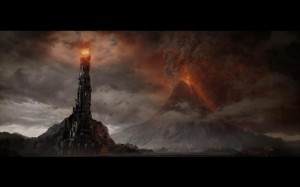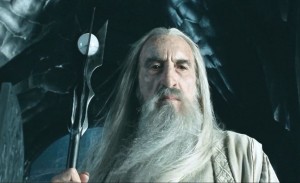Over coming days, in this four-part series, guest writer Eric M. Van will draw together the threads of known facts, and add a dash of logic to speculate on how Peter Jackson and his crew may have imagined their version of JRR Tolkien’s The Hobbit. In the first part, he takes one of the most mysterious sections, how The Necromancer, Sauron, and the wizard, Radagast the Brown, will weave into Bilbo Baggins’ much-less-epic (yet no less important) adventure.
Imagining Peter Jackson’s The Hobbit
Part 1: Sauron and Dol Guldur. Radagast and Rhosgobel

That’s the question we’re all desperately asking about Peter Jackson’s adaptation of The Hobbit. We have a collection of puzzle pieces—here a Morgul-blade, there a hedgehog—and we’re trying to put them together to make some kind of picture of the trilogy, especially the fast-approaching first installment.
But one can also simply do what the screenwriters have done: take a close look at the novel and see what changes need to be made to adapt it successfully. This humble effort thus begins with a set of solutions to all the major extant mysteries, before turning (in a series of follow-up features) to a general overview.
And, sure, that’s backwards, but I’ve got an empty Nazgûl tomb that’s just aching to be filled with some kind of sensible explanation.
One of the hallmarks of Peter Jackson’s Tolkien adaptations is the compression of story timelines. It’s always for the same reason: the Wise regard Sauron as an imminent rather than a long-term threat. In Tolkien’s The Lord of the Rings, Gandalf takes sixteen-and-a-half years to confirm that Bilbo’s ring is the One, once he first suspects it; Jackson has Gandalf accomplish this in what appears to be a single year.
(It’s about 1000 miles to Minas Tirith. A hundred miles per day is a perfectly manageable rate for a horse over adequate roads, and consistent with the 120 that Gandalf managed on Shadowfax with Pippin, according to The Atlas of Middle-earth. It would thus take less than a month to ride to Minas Tirith, view the scroll of Isildur, and return. But in the next scene both Frodo and Gandalf behave as if at least several months have passed. A full year would not only provide adequate time for Gandalf’s pursuit of and interrogation of Gollum, but maintain the seasonal timelines of the book).
Tolkien has Frodo dawdle for 163 further days before leaving Bag End; Jackson gets him out the door the next morning. If this were a contemporary film, we’d be expecting Fed Ex product placement.

Both of these timeline compressions dramatically increase the perceived threat of Sauron, but there is a second very good reason for excising the 91-year delay between confirming Sauron’s existence and attacking him. In the books (LOTR and “The Hunt for the Ring” in Unfinished Tales), the White Council meets in Rivendell a year after Gandalf has confirmed that the Necromancer of Dol Guldur is Sauron. And Gandalf does urge an immediate attack. Saruman “overrules” him (presumably by persuading Elrond, Círdan, and the other members, since there is no indication that Saruman, even as head of the Council, had ultimate authority) and Gandalf immediately suspects Saruman’s true motive: he wants the Ring for himself, and wants to leave Sauron alone so the Ring can seek its master.
In Jackson’s necessarily simplified version of the history, Saruman never overtly desires the Ring for his own; he is a true ally to Sauron rather than a false one who secretly desires to supplant him. For the most part, he turns traitor not because of his desire for power, but because he looks in the palantír and is persuaded of the utter certainty of Sauron’s victory. (In the book, this is what happens to Denethor, although he responds by despairing rather than collaborating. Denethor’s palantír was written out of the film apparently to avoid redundancy with Saruman’s; unfortunately, that had the side effect of diminishing his character, since in the movie version he has to be weak enough to fall into despair even without a push from Sauron). Since Saruman only becomes a traitor when he becomes convinced that Sauron’s victory is inevitable, he can’t possibly already be one at the time that it’s first discovered that Sauron has returned, when he is yet to rebuild Barad-Dûr or amass his armies. So the Saruman we see in The Hobbit will be unfallen (as Christopher Lee has stated in interview), and without a fallen Saruman there is no plot mechanism for delaying the attack.

In fact, I think we’ll see in this trilogy just why Gandalf regards Saruman as “both wise and powerful” (though admittedly somewhat proud, stubborn, and conservative, since he is apparently skeptical about the significance of the Morgul-blade). We’ll even see Gandalf and Saruman collaborate on creating devices to help win the Battle of Dol Guldur (in the books, credited largely to Saruman alone). And we’ll come to understand that Saruman’s invention of the Olympic Explosive Device in TTT was inspired and informed by Gandalf’s mastery of fireworks in The Desolation of Smaug; that Saruman mimics Gandalf’s magic with technology makes this a cruelly ironic application of Clarke’s Law.
Oops, I said the magic words: Morgul-blade. We’ve learned quite a bit about how the Sauron storyline has been revised for the movie, but what we’ve learned raises many further questions, some of which are so subtle that I haven’t seen them asked yet. Let’s look at what we know and what we don’t know, and see if we can figure out the missing details of this major (but quite justifiable and dramatically effective) revision of Middle-Earth history.


